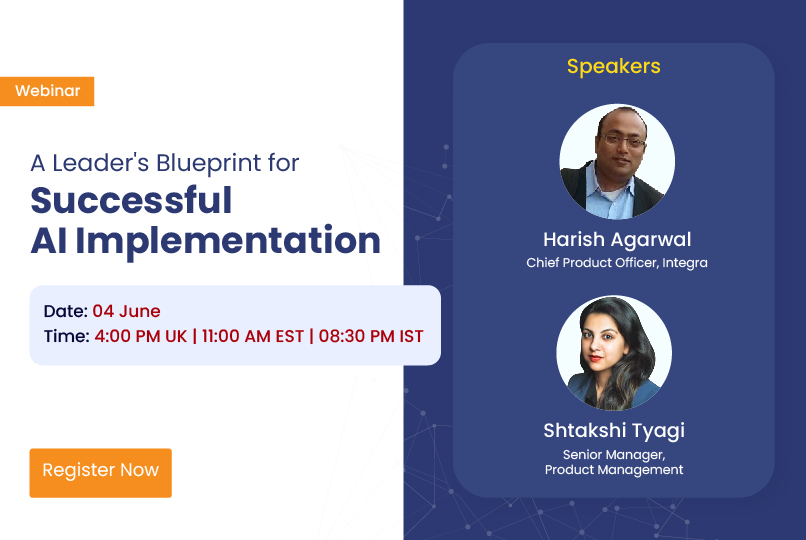Month: April 2024
Build or Buy Conversational AI Solutions – The Pros and Cons
Conversational AI is rapidly transforming how businesses interact with customers and streamline internal operations. From intelligent chatbots to virtual assistants, these AI-powered solutions are revolutionizing user experiences and optimizing workflows. The Harvard Business Review reports a surge in enterprise AI implementation, with 55% of companies accelerating their AI strategies, indicating a strong push towards digital transformation. However, when it comes to implementation, a critical decision arises: to build a custom conversational AI solution in-house or purchase a pre-built offering from a vendor.
This blog delves into the advantages and disadvantages of both approaches, empowering you to make an informed decision for your organization.
The Case for Building In-House
Developing a conversational AI solution in-house offers several advantages:
- Customization: Tailor the solution to precisely meet your specific business needs and integrate seamlessly with existing systems.
- Control: Maintain complete oversight over the development process, data security, and ongoing maintenance.
However, building in-house also presents significant challenges:
- High Initial Costs: Be prepared for substantial investments in research and development, talent acquisition (data scientists, AI engineers), and the necessary technology infrastructure. The Project Management Institute (PMI) discovered that 43% of projects surpass their original budgets, 49% are delivered late, and 14% completely fail.
- Time to Market: Lengthy development cycles can delay the deployment of the solution and impede the realization of potential benefits.
- Maintenance and Updates: Allocating resources for ongoing maintenance, updates, and bug fixes is crucial for ensuring the system’s functionality and performance.
The Case for Purchasing
Purchasing a pre-built conversational AI solution offers distinct advantages:
- Speed to Deployment: Vendor solutions can be integrated and operational much faster than in-house development, allowing you to capitalize on the benefits of conversational AI sooner.
- Cost Efficiency: Lower upfront investment compared to in-house development, with predictable ongoing costs through subscription or licensing fees.
- Expert Support: Benefit from ongoing support, maintenance, and updates provided by the vendor, ensuring your solution remains functional and secure.
However, there are also limitations to consider:
- Limited Customization: Pre-built solutions may not perfectly align with your specific needs and might require additional customization, potentially incurring further costs.
- Dependency: Reliance on external vendors for critical updates and support can limit flexibility and responsiveness.
Before Choosing an Off-the-Shelf Conversational AI Solution
While pre-built solutions offer speed and cost-efficiency, careful consideration is essential to ensure a successful implementation. Here are some key questions to ask yourself:
- Functionality: Does the solution offer the specific features and functionalities you require to address your business needs? Can it integrate with your existing systems seamlessly?
- Customization: How much customization does the solution allow? Can it be tailored to your specific industry terminology or brand voice?
- Scalability: Consider your growth projections. Can the solution scale to meet your future needs without requiring significant additional investment?
- Data Security and Privacy: Where will your customer data be stored? Does the vendor have robust security measures in place? How does the solution comply with data privacy regulations relevant to your industry? Every year, more organizations are becoming victims of cyberattacks; in fact, it’s projected that almost 30% of companies will encounter a data breach in the upcoming two years.
- Vendor Support: What level of ongoing support and maintenance does the vendor offer? Is there a dedicated customer success team to assist you with troubleshooting and optimization?
By thoroughly addressing these questions, you can ensure that an off-the-shelf solution aligns with your specific requirements and delivers the desired value for your business.
Quixl’s Approach to Conversational AI
Quixl is Integra’s innovative AI Accelerator, that revolutionizes businesses by offering rapid deployment of advanced AI. It presents a unique and versatile solution that bridges the gap between in-house development and purchasing a pre-built offering.
Quixl’s Advantages:
- Flexibility & Security: Quixl offers the customization benefits of in-house development combined with the ease of deployment of pre-built solutions, all while prioritizing the security of your customer data. Our platform adheres to industry-leading security standards.
- Speed and Efficiency: Accelerate your conversational AI journey with Quixl’s platform, realizing the benefits of AI without the extended development timelines and financial constraints of in-house projects.
- Scalability: Quixl caters to businesses of all sizes, from startups to large enterprises. Its solutions are designed to scale alongside your business needs.
- Support and Innovation: Enjoy continuous access to expert support, regular updates, and the introduction of new features, ensuring your conversational AI remains at the forefront of technological advancements.
Making the Decision
The optimal approach, whether to build or purchase a conversational AI solution, hinges on several factors:
- Business Size: Larger organizations with extensive resources might consider in-house development, while smaller businesses might benefit more from pre-built solutions.
- Resource Availability: Do you have the necessary in-house talent and infrastructure to support development?
- Technical Expertise: An honest assessment of your organization’s AI development capabilities is crucial. Gartner indicates that AI projects are prone to failure as many organizations lack the necessary training data and expertise, with 53% of them self-rating their data mining and exploitation abilities as “limited” in a CIO survey.
- Strategic Goals: Consider your long-term vision for conversational AI and how it aligns with your overall business strategy.
Quixl can simplify this decision-making process. We provide a comprehensive, cost-effective, and highly customizable conversational AI solution, tailored to your specific needs.
Choosing the right approach for implementing conversational AI is crucial for maximizing its impact on your business. By carefully considering the factors outlined above, you can determine the most suitable path forward. Quixl stands ready to be your ideal partner, empowering you to leverage the power of conversational AI quickly and efficiently. Contact our team at Quixl to schedule a free demo and discuss how our innovative platform can transform your business interactions with the power of conversational AI.


